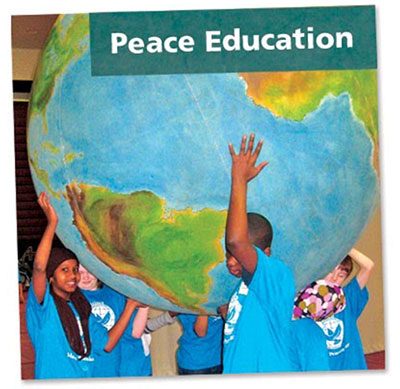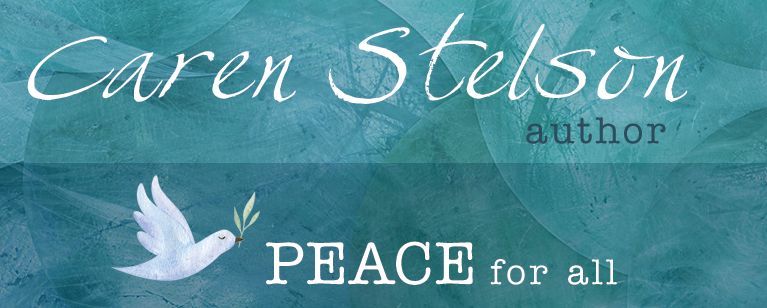Philosopher Martin Buber has a quote I admire: “All real living is meeting.” Lately, I’ve taken that quote to heart and have started asking colleagues for intentional conversations around topics we both believe are important. Last week, I asked Eden Prairie teacher Kevin McGee if we could go out to dinner and talk about something Kevin knows a great deal about: creating cultures of peace in schools.

Kevin and I serve on the Board of World Citizen, a nonprofit organization with a mission to “empower communities to educate for a just and peaceful world.” Many organizations that belong to World Citizen are schools. When I asked Kevin to share what he has learned about exploring peace in the classroom, I had no idea how deep and wide our conversation would go. Honestly, I was unprepared to absorb all that Kevin has studied and explored over his 30 years as an educator. Here’s my effort to summarize:
Kevin has worn many hats over his professional years in education. These days Kevin is an Instructional Coach in Minnesota’s Eden Prairie School District, helping classroom teachers set culturally responsive academic and social goals for their students. He is also an adjunct instructor at Hamline University in St. Paul, teaching elementary reading methods with a focus on critical literacy. Lift up Kevin’s title as Instructional Coach and Hamline Instructor and you will see his deep tap root of experience and knowledge about teaching peace—and living it.

Kevin began our discussion with his study of the Brazilian social justice educator, Paolo Freire and his book, Pedagogy of the Oppressed. Frere’s work with adult illiterate students helped him construct his view of “Critical Pedagogy,” that defines teaching, not as a neutral endeavor, but as an inherently political act that acknowledges social justice, democracy, and human rights are bound up in collaborative and active learning and teaching. This life-long, active, reflective, critical approach to learning eventually leads to the transformation of society. Freire writes in his Pedagogy of the Oppressed, “Problem-posing education affirms men and women as beings in the process of becoming.”
Given Kevin’s studies, I wondered what kind of an effect one teacher can have on the deep structure of a suburban, middle-class school district? Kevin’s response reminded me of Margaret Meads’ famous quote, “Never doubt that a small group of thoughtful, committed citizens can change the world; indeed, it’s the only thing that ever has.” In 2003, Kevin and a small group of teachers, with the principal’s support, wanted to delve deeply into the emotional and social needs of children to create peaceful environments in which students can learn. The group of teachers decided they would call themselves “The Peace Committee.”

Teachers asked: What new tools do we need in our tool box? What unifies us? How do we struggle together? How do we appreciate and acknowledge everyone—not just teachers—who works hard to make the school a safe place to learn and grow? How do we dedicate and re-dedicate ourselves to peace? What is our purpose as educators? Kevin writes in his purpose statement: “Our students deserve teachers who can ensure that all students will excel academically while developing the capacity to become change agents for peace and justice.”

As school districts around the country change with new demographics, political pressures, new administrations, new goals and expectations, pathways to peace in the schools change, too. No approach has all the answers. Kevin spoke of exploring the strengths of programs his school or entire district embraced—World Citizen, Responsive Classroom, National Urban Alliance, Restorative Justice, SEED, the Pacific Education Group, PBIS (Positive Behavior, Interventions and Support), Second Step, and Yoga Calm. What I sensed from Kevin was this: Whether a single program fully succeeds in creating a culture of peace in classrooms is not the question. What matters most is progress toward the goal. Giving up is not an option.

I reached out to Kevin one more time to ask if he would summarize his school district’s success in creating cultures of peace in the classroom and encouraging student involvement outside the school. In a recent email, Kevin wrote:
The aspect of helping students develop the habits of mind, knowledge, and skills to address social justice issues effectively, to be change agents, to address socio-political issues…to actively work for peace and justice outside of school is a harder question to address…something that is harder for us as a teaching community is to have common goals because of the diversity of perspectives and beliefs that we hold and what we believe is the goal of public education.…I think the need has been constant and the desire to address the needs is constant—but how we address those needs evolves and is re-imagined over time.
I could have spent hours talking to Kevin about learning, teaching, and living in the pursuit of peace. We never had enough time to touch on his experience in the Peace Corp teaching in Liberia, or his teaching in Morocco and Ecuador, or his two-year hiatus teaching in India. Still, I am grateful for the hour-and-a-half we shared together exploring a subject we know is important. Martin Buber was right, “All real living is meeting.”

Links to programs mentioned by Kevin McGee to advance a culture of peace in schools:
(Several of the images used in this article are from World Citizen’s peacesites.org. Pull quote designs are original content.)

